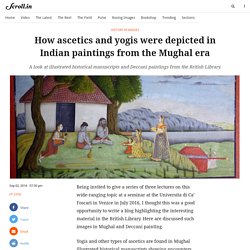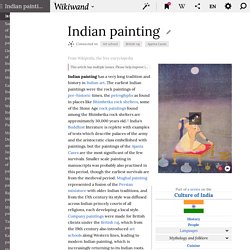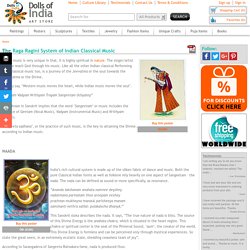

2016/02 [TOI] Good deva-bad asura divide misleading. The eternal battle between the two forces, both descended from Kashyapa, has many layers of meaning.
![2016/02 [TOI] Good deva-bad asura divide misleading](http://cdn.pearltrees.com/s/pic/th/asura-divide-misleading-times-138033921)
It cannot be seen in simple moral or ethical binaries, writes Devdutt Pattanaik. If you read the Vedas, which are nearly 4000 years old, the word 'asura' does not mean demon, or villain, but quite the opposite, a divine being. It's a title given to Indra, Agni, Rudra, Varuna, and to most Vedic deities. Vritra, the enemy of Indra, is however not called an asura.
However, things change in the Puranas, composed around 2000 years ago. If one reads the Gita, which is part of the Mahabharata, and also is roughly 2000 years old, Krishna uses devas as an adjective for positive qualities such as generosity, compassion, magnanimity, equanimity, faith and patience, while asuras embody all people who are greedy, self-absorbed, avaricious, territorial, combative and egotistical. 2016/07 [NPR] A Loeb Library For Indian Literature. This program was originally broadcast on February 10, 2015.
![2016/07 [NPR] A Loeb Library For Indian Literature](http://cdn.pearltrees.com/s/pic/th/library-indian-literature-138033929)
The stunning poetry, prose, history and philosophy of classical Indian literature. Emerging in a huge new collection. We’ll dip in. Talk of the classics, classical literature, and minds quickly go to ancient Greece and Rome. To Greek and Latin. Guests Sheldon Pollock, professor of South Asian Studies at Columbia University. Yellamma. 2016/09 How ascetics and yogis were depicted in Indian paintings from the Mughal era. Being invited to give a series of three lectures on this wide-ranging topic at a seminar at the Universita di Ca’ Foscari in Venice in July 2016, I thought this was a good opportunity to write a blog highlighting the interesting material in the British Library.

Ascetics and Yogis in Indian painting - Asian and African studies blog. Being invited to give a series of three lectures on this wide ranging topic at a seminar at the Universita di Ca’ Foscari in Venice in July 2016, it seemed a good opportunity to write a blog highlighting the interesting material in the British Library.

Here are discussed such images in Mughal and Deccani painting. Yogis and other types of ascetics are found in Mughal illustrated historical manuscripts showing encounters recorded in Mughal histories between the emperors Babur, Akbar and Jahangir; and also in indivdual album paintings. From the Mughal point of view more or less all Hindu ascetics were classed as yogis since they all practised bodily asceticisms of some kind or another. 2016/01 [Medium] The Color of Music – Medium. In 1611, a now well-forgotten cleric, William Laud became the Vice-President of St.
![2016/01 [Medium] The Color of Music – Medium](http://cdn.pearltrees.com/s/pic/th/the-color-of-music-medium-138720439)
John’s College, Oxford. Indian painting. This article has multiple issues.

Please help improve it or discuss these issues on the talk page. (Learn how and when to remove these template messages) This article needs additional citations for verification. Please help improve this article by adding citations to reliable sources. Unsourced material may be challenged and removed. (December 2014) (Learn how and when to remove this template message) This article needs attention from an expert in Visual arts.
Indian painting has a very long tradition and history in Indian art. The Raga Ragini System of Indian Classical Music. Indian music is very unique in that, it is highly spiritual in nature.

The singer/artist tries to reach God through his music. Like all the other Indian classical Performing Arts, classical music too, is a journey of the Jeevatma or the soul towards the Paramatma or the Divine. As they say, ‘Western music moves the heart, while Indian music moves the soul’. “Geetam Vadyam Nrithyam Trayam Sangeetam Uchyatey” This phrase in Sanskrit implies that the word ‘Sangeetam’ or music includes the practice of Geetam (Vocal Music), Vadyam (Instrumental Music) and Nrithyam (Dance). So this is what a full set of ragamala paintings looks like. Each raga/ragini (musical mode) is associated w/ a particular time day/season. The Traditional Indian Painting Styles You Should Know. NY antiquities dealer Nancy Wiener charged with selling stolen artifacts. A prominent New York antiquities dealer has been accused of selling stolen artifacts from international smugglers by creating sham documents to hide their history in a scheme that prosecutors said dates back to 1999.

Nancy Wiener was arrested Wednesday on charges of criminal possession of stolen property and conspiracy, according to the Manhattan district attorney's office. A raid on her gallery took place in March earlier this year. Prosecutors said she and several co-conspirators have been trafficking in illegal antiquities since at least 1999. Antiquities dealer Nancy Wiener, left, has been accused of selling stolen artifacts from international smugglers by creating sham documents to hide their history. Pictured right is a relief that was seized by authorities from her gallery. Art historian Bangdel is no more - General - The Kathmandu Post. Jul 26, 2017- Internationally acclaimed art historian Dina Bangdel, who was known for her expertise both in traditional and contemporary arts, passed away on Tuesday in the United States, her friends confirmed.

She was 54. Bangdel, associate professor at the Virginia Commonwealth University (VSU) in Qatar, had undergone surgery for sinusitis in the United States in March but infections led to meningitis that took her life. 50 Indian Cities Named After Devi or Goddess. Indian Cities named after Devi is the result of a random quiz that we posted on IndiTales FB Page and Twitter Handle.

Indus Valley. New Views of Ancient Culture Suggest Brutal Violence. They lived in well-planned cities, made exquisite jewelry, and enjoyed the ancient world's best plumbing. But the people of the sophisticated Indus civilization—which flourished four millennia ago in what is now Pakistan and western India—remain tantalizingly mysterious.
Unable to decipher the Indus script, archaeologists have pored over beads, slivers of pottery, and other artifacts for insights into one of the world's first city-building cultures. Now scientists are turning to long-silent witnesses: human bones. In two new studies of skeletons from Indus cemeteries, researchers have found intriguing clues to the makeup of one city's population—and hints that the society there was not as peaceful as it has been portrayed. Dholavira. Dholavira (Gujarati: ધોળાવીરા) is an archaeological site in Bhachau Taluka of Kutch District, in the state of Gujarat in western India, which has taken its name from a modern village 1 km (0.62 mi) south of it.
This village is 165 km from Radhanpur. Also known locally as Kotada timba the site contains ruins of an ancient Indus Valley Civilization/Harappan city. Mohenjo-daro. Location of Mohenjo-daro within the Pakistani province of Sindh. Mohenjo-daro (IPA: [muˑənⁱ dʑoˑ d̪əɽoˑ], (Sindhi: موئن جو دڙو), (Urdu: موئن جودڑو), lit. Mound of the Dead; English pronunciation: /moʊˌhɛn.dʒoʊ ˈdɑː.roʊ/), is an archeological site in the province of Sindh, Pakistan. Built around 2600 BCE, it was one of the largest settlements of the ancient Indus Valley Civilization, and one of the world's earliest major urban settlements, contemporaneous with the civilizations of ancient Egypt, Mesopotamia, and Crete.
Indus Valley - How They Managed Their Water Resources. Think of any civilization and it is almost certain that you will find that it thrived along some major river or another. The same is true in the case of the great Indus Valley Civilization. Sometime around 6000 BC nomadic tribes settled down to the west of the River Indus. They lived in small houses and sustained themselves by cultivating wheat and barley. As the years went by the climate began to change bringing along more rainfall. This resulted in a growing population. Domestic water supply The cities of the Indus valley were known for their water management. The Indus River Valley Civilization: Mohenjo-Daro and Harappa. History and Politics, Indus Valley.
Early Civilization in the Indus Valley. Cities of the Indus Valley. Indus Civilization Introduction. N fact, there seems to have been another large river which ran parallel and west of the Indus in the third and fourth millenium BCE. Indus Valley Civilization. The major sites of the Indus Valley Civilization imposed over modern borders. Harappan Civilization, Indus valley civilization. Cities of the Indus Valley. Harappan Civilization, Indus valley civilization. 50 Indian Cities Named After Devi or Goddess. Vocabulary- Ancient History.pdf. The Celts and The Iberians. Ancient history: Phoenicians and Carthaginians. History for Primary Education. Ancient History: the Greeks. History for Primary Education. Ancient History: Iberians and Celts. History for Primary Education. Educational Video for Kids. Educational Video for Kids. Unnamed. Unnamed. Unnamed.